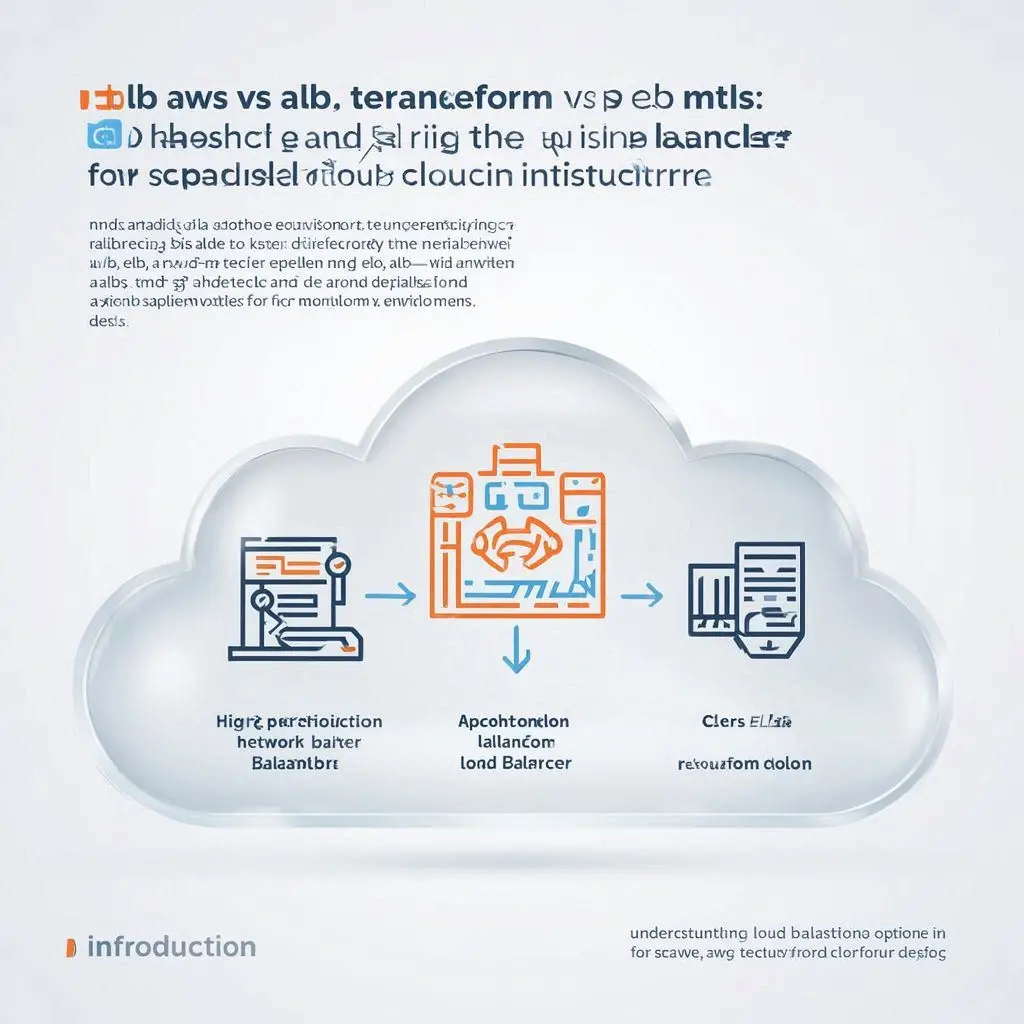
NLB AWS vs ALB Terraform vs ELB mTLS: Choosing the Right Load Balancer for Scalable Cloud Infrastructure
Introductory Paragraph :
Navigating the AWS ecosystem requires understanding the key differences between NLB, ALB, and ELB—especially when integrating Terraform and mTLS. This guide compares NLB AWS vs ALB, ELB, and deployment options with Terraform for modern cloud environments.
INTRODUCTION
Understanding Load Balancing Options in AWS for Scalable, Secure Cloud Deployments
In a cloud-native architecture, selecting the right load balancer directly impacts performance, cost-efficiency, and security. AWS offers several choices—namely Network Load Balancer (NLB), Application Load Balancer (ALB), and Classic Load Balancer (ELB)—each serving different use cases. Exploring NLB in contrast to ALB and ELB, the article outlines core distinctions, automation strategies using Terraform, and the advantages of implementing mTLS. By mastering these concepts, professionals can develop high-performing and fault-tolerant cloud environments.
NLB AWS
Summary: NLB AWS delivers ultra-low latency and high-throughput load balancing for network-level traffic in large-scale, real-time applications.
What Is AWS NLB and What Are Its Best Use Cases?
With the ability to manage massive traffic volumes at lightning speed, the AWS NLB delivers high throughput and minimal latency, making it ideal for performance-critical applications. Unlike its counterparts, NLB operates at Layer 4 (Transport Layer), allowing it to forward TCP, UDP, and TLS traffic directly to targets.
Key features of NLB AWS include:
- Thanks to its support for static and Elastic IPs, the load balancer benefits from stable IP allocation and simplified domain name management.
- Integration with PrivateLink, enabling secure connections to AWS services across VPCs.
- TLS termination and pass-through options.
- High resiliency and automatic scaling.
NLB is ideal for latency-sensitive applications such as VoIP, gaming, or financial platforms. It's particularly favored in hybrid cloud environments and microservices architectures due to its performance characteristics and scalability.
ALB VS NLB AWS
Summary: ALB vs NLB AWS compares Layer 7 intelligent routing with Layer 4 high-performance forwarding, each suited to distinct architectural needs.
Comparing ALB and NLB: Use Cases and Performance Trade-offs
ALB and NLB differ in their OSI model operations—ALB works at Layer 7, providing intelligent routing for web-based protocols such as HTTP/HTTPS and enabling capabilities such as:
Path-based and host-based routing.
- WebSocket and HTTP/2 support.
- User authentication via Cognito or OIDC.
In contrast, NLB is built for speed and raw network performance, making it the go-to for non-HTTP workloads or when maintaining client IP addresses is critical.
|
Feature |
ALB |
NLB |
|
Protocol |
HTTP/HTTPS |
TCP/UDP/TLS |
|
IP Preservation |
No |
Yes |
|
Target Types |
IP, Lambda, EC2 |
IP, EC2 |
|
Use Case |
Web applications |
Real-time and hybrid apps |
Choosing between ALB vs NLB AWS largely depends on your traffic type, security needs, and required routing logic.
TERRAFORM NLB AWS
Summary: Terraform NLB AWS enables infrastructure as code (IaC) for scalable, repeatable load balancer provisioning across environments.
Deploying AWS NLB with Terraform: A Clean, Automated Approach
Terraform is a widely used infrastructure as code (IaC) tool that allows DevOps teams to automate the creation and management of AWS resources, including Network Load Balancers (NLBs). With Terraform, infrastructure can be written as declarative code and deployed consistently across multiple environments such as development, staging, and production.
To set up an NLB in Terraform, you typically define the load balancer, configure a listener to accept traffic, and establish a target group that sends that traffic to backend systems.
First, you define the load balancer by specifying its name, type (which is "network" in this case), and the subnets it should be deployed in. You can also enable deletion protection for safety.
Next, you create a listener that listens for incoming traffic on a specific port—usually port 443 for TLS (encrypted) traffic. This listener uses an SSL certificate stored in AWS Certificate Manager (ACM), and you define a security policy that governs which TLS versions and ciphers are allowed.
Finally, you set up a target group, which is a collection of endpoints (such as EC2 instances or IP addresses) that will receive the traffic. You assign a port and protocol to this group, and link it to the NLB listener so that traffic is correctly forwarded.
With Terraform variables, your configurations become more adaptable, scalable, and environment-agnostic. For example, subnet IDs, VPC ID, and certificate ARNs can all be passed in as variables, making the setup reusable and modular.
To ensure best practices, it's recommended to wrap your NLB configuration into reusable modules, store sensitive data securely, and integrate Terraform with CI/CD pipelines for automated deployment and updates. These methods enhance scalability, reliability, and traceability across cloud infrastructure.
In short, Terraform simplifies the deployment of AWS NLBs by providing structure, consistency, and automation—three foundational principles of today’s DevOps methodology.
ELB VS NLB AWS
Summary: ELB vs NLB AWS illustrates the evolution from basic classic load balancing to modern, high-performance networking with NLB.
Classic Load Balancer vs NLB: Is ELB Still Relevant?
Elastic Load Balancer (ELB), often referred to as the "Classic Load Balancer," predates ALB and NLB. It enables standard Layer 4 and Layer 7 traffic distribution, yet it lacks the high-speed performance and modern capabilities of newer AWS load balancers.
Here’s a comparison:
|
Capability |
ELB (Classic) |
NLB |
|
Performance |
Moderate |
High |
|
TLS Termination |
Yes |
Yes |
|
Static IP Support |
No |
Yes |
|
PrivateLink Support |
No |
Yes |
NLB AWS is preferred for modern workloads requiring scalability, static IPs, and integration with VPC endpoints, rendering ELB less favorable except for legacy use cases.
MTLS NLB AWS
Summary: mTLS NLB AWS enables mutual authentication between clients and servers for highly secure, encrypted traffic in sensitive applications.
Securing NLB with Mutual TLS (mTLS) in AWS
Mutual TLS ensures secure connections by enforcing certificate-based authentication on both the client and server sides. In the context of NLB AWS, TLS listeners can be configured for mTLS to ensure secure, end-to-end communication.
Steps to configure mTLS in NLB:
- Ensure your certificate chains for both client and server are uploaded to AWS ACM to support mutual TLS configuration.
- Configure the NLB TLS listener with client_authentication as require.
- Ensure your backend targets support certificate-based authentication.
This configuration is particularly useful for:
- Zero-trust architectures.
- Internal microservice-to-microservice communications.
- Regulatory-compliant applications in healthcare, fintech, or defense sectors.
mTLS NLB AWS strengthens security without sacrificing performance, leveraging NLB’s native TLS handling.
CONCLUSION
Choosing the Right Load Balancer Strategy with NLB AWS at the Core
Selecting between NLB, ALB, and ELB requires careful consideration of application requirements, security standards, and operational workflows. While ALB is best for intelligent routing and web apps, NLB AWS excels in high-speed, scalable network-level traffic management—especially when deployed via Terraform and secured with mTLS. Legacy ELBs may still have a place in backward-compatible systems but are increasingly phased out in favor of NLB’s robust features. For cloud architects and DevOps teams, adopting NLB AWS in infrastructure automation and secure communication design ensures future-ready, resilient cloud deployments.
FAQs (Optional SEO Enhancers):
Q1: What is the main difference between NLB and ALB in AWS?
A: NLB operates at Layer 4 and is optimized for performance and low latency, while ALB operates at Layer 7, offering advanced routing and web application features.
Q2: Can NLB in AWS terminate TLS connections?
A: Yes, NLB supports TLS termination and passthrough, including mutual TLS for secure communications.
Q3: Is Terraform good for managing AWS NLB?
A: Absolutely. Terraform offers a scalable, automated approach to provisioning and managing NLBs in different environments.

